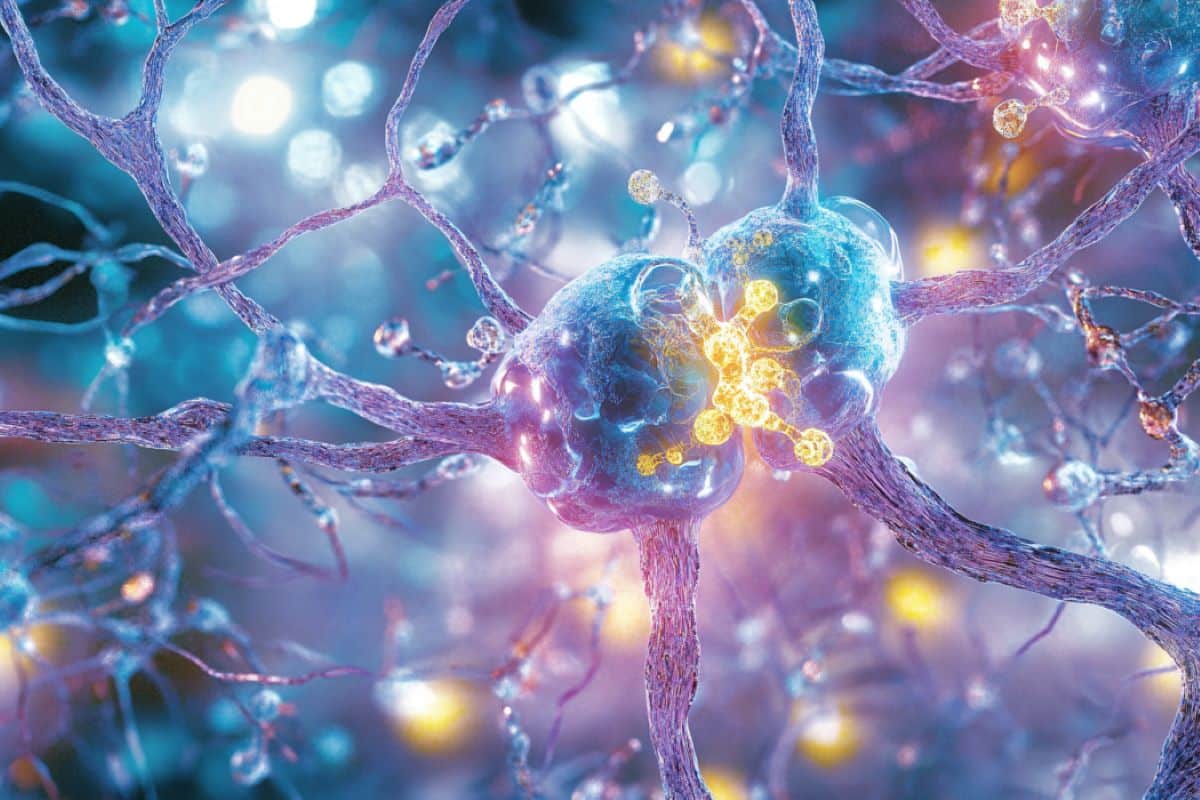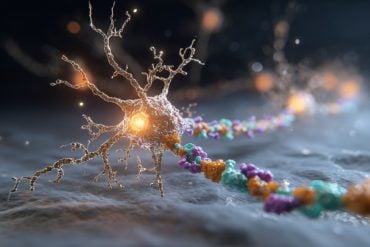Summary: Researchers have identified a protein complex, TrkC-PTPσ, that plays a key role in the structural organization of synapses in the brain, impacting cognitive behaviors. By studying this complex, scientists uncovered how it regulates synaptic protein phosphorylation, essential for healthy brain function. Disruptions in this protein complex led to anxiety-like behaviors in mice, providing insights into mental health conditions like anxiety and autism.
The study sheds light on synaptic mechanisms that could help develop new therapeutic strategies. These findings advance our understanding of synapse function and its role in cognitive disorders, bringing hope for targeted treatment options in the future.
Key Facts:
- The TrkC-PTPσ protein complex controls synapse organization and function.
- Disruptions in this complex led to anxiety-like and avoidance behaviors in mice.
- Findings may support therapeutic approaches for mental health conditions linked to synaptic defects.
Source: University of Montreal
Scientists at Université de Montréal and its affiliated Montreal Clinical Research Institute (IRCM) have uncovered unique roles for a protein complex in the structural organization and function of brain cell connectivity, as well as in specific cognitive behaviors.
The work by a team led by Hideto Takahashi, director of the IRCM’s synapse development and plasticity research unit, in collaboration with Steven Connor’s team at York University and Masanori Tachikawa’s team at Japan’s Tokushima University is published in The EMBO Journal.

Although defects in synapse organization are linked to many neuropsychiatric conditions, the mechanisms responsible for this organization are poorly understood. The new study’s findings could provide valuable therapeutic insights, the researchers believe.
Two goals are important to bear in mind with this research, said Takahashi, an associate research medical professor in molecular biology and neuroscience at UdeM.
“One is to uncover novel molecular mechanisms for brain cell communication,” he said.
“The other is to develop a new unique animal model of anxiety disorders displaying panic disorder- and agoraphobia-like behaviors, which helps us develop new therapeutic strategies.”
Understanding the mechanisms
Mental illnesses, such as anxiety disorders, autism and schizophrenia are among the leading health disorders in Canada and worldwide. Despite their prevalence, drug development and treatment for many of these illnesses have proven to be very challenging, due to the complexity of the brain.
Scientists have therefore strived to understand the underlying mechanisms that lead to cognitive disorders in order to advance therapeutic strategies.
The junctions between two brain cells (neurons) are called synapses, which are essential for neuronal signal transmission and brain functions. Defects in excitatory synapses, which activate signal transmission to target neurons, and those in synaptic molecules predispose to many mental illnesses.
Takahashi’s team has previously discovered a new protein complex within the synaptic junction, called TrkC-PTPσ, which is only found in excitatory synapses. The genes coding for TrkC (NTRK3) and PTPσ (PTPRS) are associated with anxiety disorders and autism, respectively.
However, the mechanisms by which this complex regulates synapse development and contributes to cognitive functions are unknown.
The work carried out in the new study by first author Husam Khaled, a doctoral student in Takahashi’s laboratory, showed that the TrkC-PTPσ complex regulates the structural and functional maturation of excitatory synapses by regulating the phosphorylation, a biochemical protein modification, of many synaptic proteins, while disruption of this complex causes specific behavioral defects in mice.
Building blocks of the brain
Neurons are the building blocks of the brain and the nervous system that are responsible for sending and receiving signals that control the brain and body functions. Neighboring neurons communicate through synapses, which act like bridges that allow the passage of signals between them.
This process is essential for proper brain functions such as learning, memory and cognition. Defects in synapses or their components can disrupt communication between neurons, and lead to various brain disorders.
By generating mice with specific genetic mutations that disrupt the TrkC-PTPσ complex, Takahashi’s team uncovered the unique functions of this complex. They demonstrated that this complex regulates the phosphorylation of many proteins involved in synapse structure and organization.
High-resolution imaging of the mutant mice brains revealed abnormal synapse organization, and further study of their signaling properties showed an increase in inactive synapses with defects in signal transmission.
Observing the behavior of the mutant mice, the scientists saw that they exhibited elevated levels of anxiety, especially enhanced avoidance in unfamiliar conditions, and impaired social behaviors.
About this study
Funding: Funding was provided by the Natural Sciences and Engineering Research Council of Canada, the Canadian Institutes of Health Research grants, the Fonds de la recherche du Québec research scholars (FRQS) and the U.S. National Institutes of Health. Husam Khaled was a recipient of an FRQS Doctoral Scholarship and the IRCM Emmanuel-Triassi Doctoral Scholarship for this study.
About this mental health and genetics research news
Author: Julie Gazaille
Source: University of Montreal
Contact: Julie Gazaille – University of Montreal
Image: The image is credited to Neuroscience News
Original Research: Open access.
“The TrkC-PTPσ complex governs synapse maturation and anxiogenic avoidance via synaptic protein phosphorylation” by Hideto Takahashi et al. EMBO Journal
Abstract
The TrkC-PTPσ complex governs synapse maturation and anxiogenic avoidance via synaptic protein phosphorylation
The precise organization of pre- and postsynaptic terminals is crucial for normal synaptic function in the brain. In addition to its canonical role as a neurotrophin-3 receptor tyrosine kinase, postsynaptic TrkC promotes excitatory synapse organization through interaction with presynaptic receptor-type tyrosine phosphatase PTPσ.
To isolate the synaptic organizer function of TrkC from its role as a neurotrophin-3 receptor, we generated mice carrying TrkC point mutations that selectively abolish PTPσ binding.
The excitatory synapses in mutant mice had abnormal synaptic vesicle clustering and postsynaptic density elongation, more silent synapses, and fewer active synapses, which additionally exhibited enhanced basal transmission with impaired release probability.
Alongside these phenotypes, we observed aberrant synaptic protein phosphorylation, but no differences in the neurotrophin signaling pathway.
Consistent with reports linking these aberrantly phosphorylated proteins to neuropsychiatric disorders, mutant TrkC knock-in mice displayed impaired social responses and increased avoidance behavior.
Thus, through its regulation of synaptic protein phosphorylation, the TrkC–PTPσ complex is crucial for the maturation, but not formation, of excitatory synapses in vivo.






